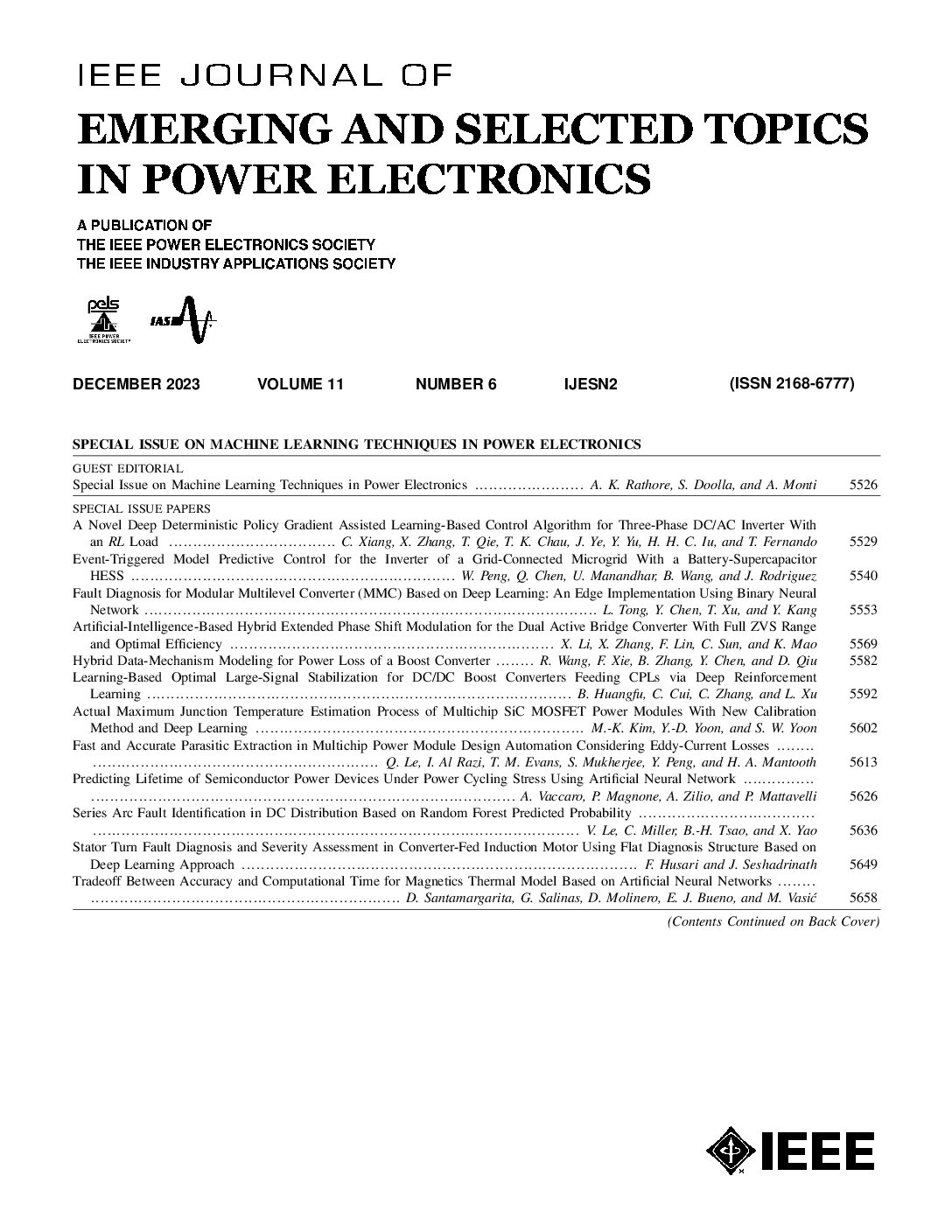Parameter Estimation and Control of Axial Flux Permanent Magnet Motors for Electric Aircraft: Evaluating Axial Force Implications in Field-Oriented Control Methods
IF 4.9
2区 工程技术
Q1 ENGINEERING, ELECTRICAL & ELECTRONIC
IEEE Journal of Emerging and Selected Topics in Power Electronics
Pub Date : 2025-03-17
DOI:10.1109/JESTPE.2025.3552081
引用次数: 0
Abstract
Axial flux permanent magnet (AFPM) motors are emerging as a promising technology for electrifying transportation due to their high specific power, torque, and efficiency. A model of a motor is developed, demonstrating that the inductance matrix of this AFPM motor differs from typical machines primarily due to the fractional slot concentrated winding (FSCW). This article provides a comprehensive parameter estimation of the ASCEND motor utilizing finite element analysis (FEA) for parameter estimation across a wide range of operating conditions and a field-oriented control (FOC) algorithm based on the motor model derived from FEA parameter estimation, utilizing two three-level active neutral point clamped (ANPC) inverters with half-bridge silicon carbide (SiC) modules. A tailored approach to current trajectory, incorporating maximum torque per amp (MTPA) and maximum torque per loss (MTPL) strategies, is developed to optimize torque acquisition and assess the impact of current variations on axial forces imposed on the rotor. The application of the negative d-axis current reduces axial forces by approximately 11% with MTPA and 24% with MTPL at speed of 5000 r/min and peak torque. Implementing the control system with a similar motor topology shows that the model aligns well with experimental results, with speed and torque discrepancies of less than 3%.电动飞机用轴向磁通永磁电机的参数估计与控制:评估轴向力在磁场定向控制方法中的意义
轴向磁通永磁(AFPM)电机由于其高比功率、扭矩和效率,正在成为一种有前途的电气化运输技术。建立了一个电机模型,表明该AFPM电机的电感矩阵与典型电机的电感矩阵不同,主要是由于分数槽集中绕组(FSCW)。本文提供了ASCEND电机的综合参数估计,利用有限元分析(FEA)在广泛的工作条件下进行参数估计,并基于从FEA参数估计中得出的电机模型,利用两个三电平有源中点箝位(ANPC)半桥碳化硅(SiC)模块逆变器,提供了场定向控制(FOC)算法。结合最大扭矩/安培(MTPA)和最大扭矩/损耗(MTPL)策略,开发了一种针对电流轨迹的定制方法,以优化扭矩采集并评估电流变化对转子轴向力的影响。在速度为5000 r/min和峰值扭矩时,负d轴电流的应用使MTPA的轴向力降低了约11%,MTPL的轴向力降低了24%。用相似的电机拓扑实现控制系统表明,模型与实验结果吻合良好,速度和转矩差异小于3%。
本文章由计算机程序翻译,如有差异,请以英文原文为准。
求助全文
约1分钟内获得全文
求助全文
来源期刊

IEEE Journal of Emerging and Selected Topics in Power Electronics
ENGINEERING, ELECTRICAL & ELECTRONIC-
CiteScore
12.50
自引率
9.10%
发文量
547
审稿时长
3 months
期刊介绍:
The aim of the journal is to enable the power electronics community to address the emerging and selected topics in power electronics in an agile fashion. It is a forum where multidisciplinary and discriminating technologies and applications are discussed by and for both practitioners and researchers on timely topics in power electronics from components to systems.
 求助内容:
求助内容: 应助结果提醒方式:
应助结果提醒方式:


